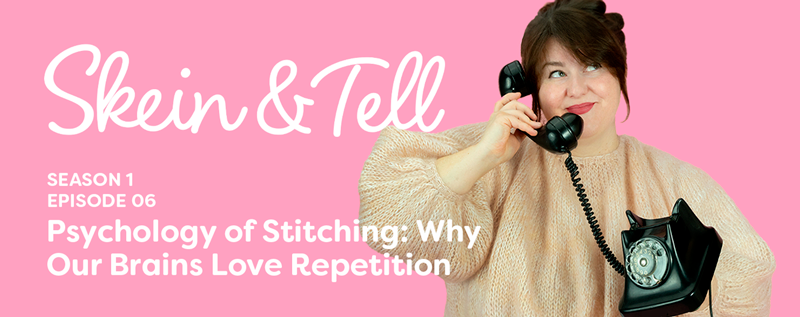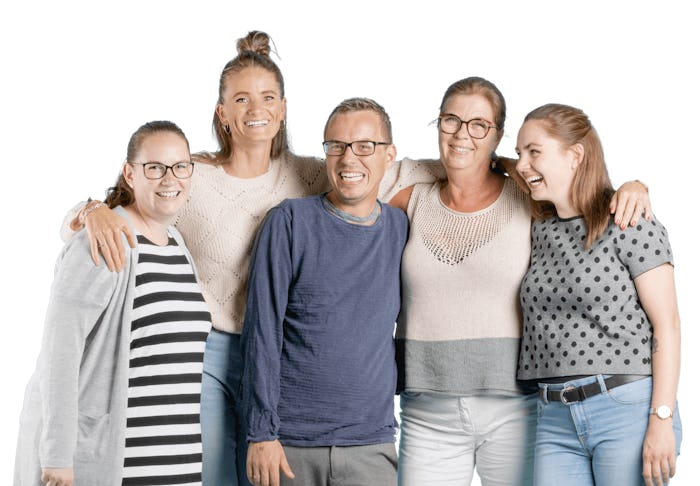Whether you're curious about the cognitive benefits of your favorite hobby or looking for more reasons to stitch away stress, this episode will have you reaching for your hooks and needles with a newfound appreciation for how they're benefiting your brain.

Welcome to episode 6 of Skein and Tell, Hobbii’s official podcast, where yarn lovers unite to explore all things fiber, community, and creativity. 🧶
Join host Gea and special guest Kat from Product Procurement in this fascinating episode of Skein and Tell as they unravel the science behind why fiber arts feel so good! Discover the surprising neurological reasons your brain gets hooked on the repetitive motions of knitting and crocheting.
This episode combines humor, personal experiences, and solid science to explain why your crafting habit isn't just a hobby... It's practically self-care! Kat and Gea's playful banter makes complex neuroscience accessible and entertaining, giving you the perfect justification for your yarn addiction.
Listen to Skein and Tell Episode 6 Now
Ready to hear it all straight from Gea? 🎙️ Press play, or scroll down to read the full transcript below.
Choose Where to Listen:
Here's what you'll learn in this episode:
👋 (0:10) Say hi to Gea & Kat
🧠 (3:43) How your motor cortex creates "highways" for stitching movements, turning them into automatic actions
✨ (10:11) The "holy trinity of happy chemicals" released in our brains during crafting
📈 (12:46) Why finding what "flow state" is
😊 (14:55) The scientific evidence showing fiber arts can reduce anxiety and depression symptoms
Can’t tune in right now? Catch everything Gea covers in the episode below.
Want More? Read the Entire Episode
Below is an edited transcript from Episode 6: The Psychology of Stitching and Why Our Brains Love Repetition, originally presented on the Skein and Tell podcast.
Gea: Hi yarn bestie! Gea here! Welcome to Skein and Tell, the podcast that unravels it all.
Grab your hooks, baby, grab your needles, and maybe a warm drink, because today, we’re unraveling the mystery of why our brains are totally hooked on stitching.
And I have a super, super, super duper uber duper special guest in the house – our precious bestie, a.k.a. number one product developer, a.k.a. biggest yarn nerd I know: KAT!
Kat: Hello everyone! Kat here from P&P.
Gea: Kat, do you know that feeling when you’re just in it – knitting or crocheting – and you realize you’ve practically grown roots in the spot you’re sitting?
Kat: Nope. I have three daughters. Sitting still without interruption? Luxury I do not know.
Gea: Fair. But honestly, you only need one kid to lose that luxury. It gets easier, but still… I used to have time to just sit on the couch, pick a project, and stitch away. Those were the days when the house was clean and peaceful.
Kat: Right? It’s not like we don’t have time to craft, it’s that the time keeps getting filled with other stuff. Dishes, cleaning, life.
Gea: Exactly. But remember those times when you just got washed away into your stitching?
There’s actually some fascinating science behind why we zone out like that when we craft. That’s what we’re diving into today: why stitching makes our brains so darn happy.
Kat: So this is the episode for anyone who wants a scientific excuse for their yarn addiction?
Gea: Precisely. Just to clarify – we’re not neuroscientists or psychologists. But we are very curious and very experienced stitchers.
Kat: And staying informed about the yarn world is part of the job! There’s been so much new research lately about crafting and the brain.
Gea: So, let’s get into it. First up, your motor cortex. It’s basically the choreographer of all your movements.
Kat: Oh yes! When you first learn to knit or crochet, your motor cortex is working overtime.
It’s tough getting your fingers to cooperate.
Gea: Totally. I remember being a frustrated kid watching my grandma crochet so fast. And teaching Matti recently? Same deal. He was like, “How do I do this?”
Kat: I tried teaching my husband once. Disaster. He couldn’t get his fingers to do anything. I had to stop him before he broke something – like his fingers.
Gea: I keep trying to convince Sebastian to try, but he’s like, “Nope, that’s your thing.” But it could help him meditate! Or focus. He says he already does things for that, though.
Kat: Classic.
Gea: But once your motor cortex gets used to the movements, your brain creates these neural highways, it starts going, “Oh, we’re doing that again? Got it.”
Kat: Exactly. I hadn’t knit for 14 years, and then one day in Canada, I picked up needles again – and boom! My fingers remembered everything.
Gea: Same for me! I learned when I was a kid, forgot for over a decade, and when I picked it up again, it was like my hands had a memory of their own. It’s wild.
Kat: It’s like riding a bike. Once your brain knows, it just knows.
Gea: Which is why we can watch Netflix, have a conversation, and knit all at the same time.
Kat: Or at least some of us can. Multitasking is not my strong suit.
Gea: Fair! But even if you’re just focusing on the stitching, there’s a reason it feels so good. Your brain starts pumping out dopamine, serotonin, and endorphins – the holy trinity of happy chemicals.
Kat: Dopamine gives you that little reward boost when you finish a row. Serotonin lifts your mood – why you feel better after a rough day. And endorphins? They’re natural painkillers.
Gea: That explains why so many people stitch through chronic pain. My grandma does it, she forgets about her arthritis when she’s crocheting.
Kat: Her brain is basically self-medicating. Beautiful.
Gea: And this happy chemical cocktail helps us get into the flow state – that place where time disappears and your mind just... calms.
Kat: Scientists say flow happens when an activity is just the right amount of challenging. Like a pattern that keeps you engaged but doesn’t make you throw your yarn across the room.
Gea: Exactly! It’s like meditation, but with a scarf at the end.
Kat: I’ll take the scarf, thanks.
Gea: It’s this paradox: your brain zones out, but also becomes more focused. You’re relaxing, but creative ideas start flowing. It’s like a cognitive reset.
Kat: Stitching creates this tiny bubble of order in a messy world. Stitch by stitch, you build a predictable pattern, it’s comforting.
Gea: And it’s not mindless. It’s brain CrossFit. You’re reading, counting, visualizing, problem-solving – especially when you mess up and have to frog something.
Kat: That's when the brain gymnastics really kick in, figuring out where you went wrong, how to fix it, whether to rip back...
Gea: Bless the hearts of those who think it’s just “granny work.” I love you, cousin Adina, but knitting is brain work.
Kat: And now science backs us up! One study found that 81% of people with depression felt better after knitting. That’s huge.
Gea: Better than a lot of medications, and the only side effect is too much yarn.
Kat: Stitching channels anxious thoughts into something constructive. It’s like telling your anxiety, “Hey, hold this for a sec – I’m counting stitches.”
Gea: There’s a great book: Beyond Anxiety by Martha Beck. She says anxiety and creativity can’t exist in the brain at the same time. So when you start creating, your brain literally can’t be anxious.
Kat: Makes total sense. I see it in Seb – when he’s anxious, he draws. Flow state kicks in, and his mind calms down.
Gea: You don’t have to be anxious or depressed to benefit, though. Stitching just feeds your brain. I can’t count how many times I’ve picked up my hook when I felt awful, and it helped.
Kat: Sometimes, just having a break from your own thoughts helps you realize: not every thought is reality. Stitching gives your brain that space.
Gea: So yeah, when we stitch, we’re not just making cozy things. We’re giving our brains a spa day.
Kat: Repetitive motion calms us, creativity lifts us, and finishing a project gives us that sweet dopamine hit.
Gea: So whether you’re anxious, need a mental boost, or just trying not to fall asleep in a meeting, stitching’s got your back. And now you’ve got the science to prove it.
Kat: So next time someone asks why you “waste time” knitting, just smile and say you’re practicing neuroscience.
Gea: That usually shuts them up! Thanks for joining us today, Kat. And for the book rec, I’ll definitely check out Beyond Anxiety.
Kat: Thanks for having me. Always love chatting yarn and brain chemistry.
Gea: And to our listeners, don’t forget to follow, leave a review, or send us a telepathic high five. Until next time, keep those stitches flowing, the happy chemicals pumping – and remember: It’s not a yarn problem. It’s a yarn solution! Alright, love you bestie, talk soon, bye!
Ready for Next Episode?
Check out our next episode:
Skein and Tell Ep. 7: Yarn Weights Decoded - Choose the Right Yarn and Substitute like a Pro
